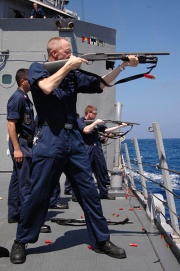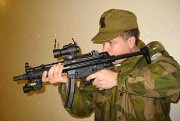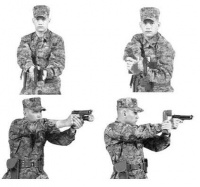Tactical light
A tactical light is a flashlight used in conjunction with a firearm to aid low light target identification and allows the marksman to simultaneously aim and illuminate the target. Tactical lights can be handheld or mounted to the weapon with the light beam parallel to the bore. Tactical lights also serve a role as a method of non-lethal force, used to temporarily blind and disorient the target[1][2].
Contents |
[edit] Handheld lights
Handheld lights are generally restricted to use with handguns, as long guns require two hands to operate. While just about any handheld flashlight can serve in the role of tactical light with the proper technique, some features are more readily adapted to the role. Some manufacturers, most prominently SureFire, sell lights specifically designed for use as handheld tactical lights. Police training programs in shooting while holding a flashlight date back to at least the 1930s.
To use a handheld light as a tactical light, the handgun is held in one hand, and the light in the other. There are a variety of positions that can be used to allow the light and handgun to be held parallel and provide mutual support, or the light can be held off to the side of the body to present a false target to a potential assailant.[3] Since the weapon and light are not attached to each other, the light may be used to illuminate areas that may or may not contain a target, without pointing the weapon at the area. If a target is detected, the handgun can quickly be brought into line to cover the target[4].
A flashlight intended to be used in this way will have provisions for ease of use when used with a handgun. Some models will have a narrow body and a ring designed to fit through the fingers, allowing the light to be used in a tight two handed grip on a handgun, with the switch controlled by pulling back with the fingers on the ring.[5] More traditional models can be used as well, but a push button switch mounted where it can easily be manipulated while in the firing position is best.[6] this way the light can be turned off to minimize the ability of an assailant to locate the user, and turned on as needed to quickly locate and engage a target. Another useful feature is the ability to attach a lanyard to the light, allowing the light to be secured to the hand holding it; this allows the light to be dropped if the hand is needed (for a magazine change, for example) and quickly retrieved.
Police often use large flashlights which, when held correctly, can double as a club and as a tactical light. The flashlight is held in the weak hand, with the back of the flashlight extending past the thumb. This allows the light to quickly be reversed, swinging the back end of the light forward to strike the target or block a blow. The strong hand can then be used to draw a sidearm, and place the hands back to back to provide support and illumination in the firing position.
[edit] Weapon mounted lights

Weapon mounted lights offer hands-free use, leaving the operator free to use both hands to control the weapon. Weapon mounted lights are most commonly seen on rifles, shotguns, and submachine guns, but they are becoming more common on handguns as well. These lights are often much more expensive than the handheld lights, since they must be sufficiently robust to withstand the recoil of the firearm, and the dedicated mounting hardware also adds to the price. One downside of the weapon mounted light is that it is always aimed parallel to the bore, so illuminating an object means that it is also targeted. Because of this, weapon mounted lights may not be appropriate under some rules of engagement.
Weapon mounted lights used to be specific to particular models of firearm, and to some extent that is still true; for example, Surefire makes a dedicated light that replaces the forend of the Mossberg 500 shotgun[7]. On the other hand, many modern firearms are incorporating Picatinny rail systems, allowing any appropriately sized Picatinny compatible system to be attached. Other mounting systems are simple clamps, designed to mount most cylindrical lights parallel to the barrel of most firearms[8]. Another unique mounting system attaches the flashlight to the bottom of the pistol magazine, such as the design developed by TACM3, for example[9]. A disadvantage of a weapon mounted light is that the beam of light will give away the location of its user[10]. Using an infrared light in conjunction with night vision goggles can mitigate this concern, so long as the target lacks night vision. Also partially mitigating this risk associated with a visible light tactical light is the ability of the tactical light user to temporarily disrupt the night vision of the target.
[edit] Lighting features
Since tactical lights are intended for use in situations where lethal force is likely to be used, reliability is a high priority.
[edit] Battery technology
Lithium battery technology is commonly used with tactical lights, such as Surefire's models, due to the very long shelf life and gradual voltage decay over the battery's lifetime. Alkaline battery technology also provides long shelf life, but has a more rapid drop-off than lithium batteries, but provides the best price/performance value for a non-rechargeable. Rechargeable batteries, such as NiMH and Nicad, offer the best cost performance for lights with heavy usage, but the relatively rapid self discharge compared to alkaline and lithium batteries limit their use.[11]
[edit] Bulb technology
Bulbs are chosen based on the desired light output and battery life. Generally, high performance bulbs are used, such as xenon bulbs or high power LED lights. LED lighting offers maximum battery life, due to the efficiency of the LEDs, and recent technology has greatly increased the light output of LEDs. Though they are older technology, xenon bulbs still offer the brightest light levels, though with much reduced run-times over the more efficient LEDs.[11]
[edit] Illumination types
Tactical lights can be fitted with lenses to produce certain colors, Colored lights or filters provide flexibility for different purposes. Red lights are best for preserving night vision due to their minimal impact on the rod cells in the eye, while green light provides high contrast for detecting blood.[11] Light in the infrared spectrum is only visible through night vision devices, allowing the operator to see clearly while reducing the visibility to those not equipped with night vision equipment.
Tactical lights are also sometimes combined with a laser to form a multifunction unit, able to provide low light targeting, illumination, or both.
[edit] References
- ↑ The Martialist: The Magazine For Those Who Fight Unfairly
- ↑ How to Choose a Tactical Flashlight from SureFire
- ↑ McGivern, p. 322
- ↑ United States Marine Corps Reference Publication 3-01B section 10
- ↑ Review of SureFire M3 tactical flashlight
- ↑ http://www.spw-duf.info/flashlight.html S. P. Wenger's Defensive Use of Firearms: Shooting with Flashlights]
- ↑ SureFire forend replacement for Mossberg 500/590 shotguns
- ↑ TacStar offers a variety of tactical lights and generic weapon mounts
- ↑ Law Enforcement Product News, July-August 1995
- ↑ Discussion of tactical accessories
- ↑ 11.0 11.1 11.2 Flashlight Buyer's Guide
[edit] External links
- U. S. Marine Corps MCRP 3-01B, Pistol Marksmanship, Chapter 10, Low Light and Darkness Techniques

